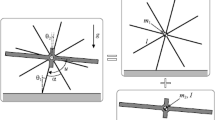Abstract
This paper discusses a method for achieving high-speed collisionless walking of a point-footed walker. First, we introduce a model of an underactuated rimless wheel with an internal reaction wheel for analysis, and develop two controllers for the single-limb support and double-limb support phases so that they minimize the corresponding control period based on the principle of the minimum-time control. The former is determined under the unilateral constraint condition, whereas the latter is determined under the constraint condition of the zero-moment point for maintaining double-limb support, respectively. Second, we extend the results obtained for generation of the highest speed collisionless walking gait without including double-limb support phases by appropriately setting the initial angular velocity of the reaction wheel. The approximate analytical solution of the target initial angular velocity is derived using the linearized model, and that of the nonlinear model is numerically obtained using a bisection method. The validity of the proposed methods is investigated through numerical simulations.









Similar content being viewed by others
Explore related subjects
Discover the latest articles, news and stories from top researchers in related subjects.References
Westervelt ER, Grizzle JW, Chevallereau C, Choi JH, Morris B (2007) Feedback control of dynamic bipedal robot locomotion. CRC Press, Boca Raton
Gomes MW, Ahlin K (2015) Quiet (nearly collisionless) robotic walking. In: Proceedings of the 2015 IEEE International Conference on Robotics and Automation, pp 5761–5766
Asano F, Zheng Y, Xiao X (2016) Generation of underactuated bipedal gait completing in one step. In: Proceedings of the 2016 IEEE/RSJ International Conference on Intelligent Robots and Systems, pp 2050–2055
Asano F, Zheng Y, Xiao X (2017) Time-scale control approaches to collisionless walking of underactuated rimless wheel. J Robot Mechatron 29(3):471–479
Bryson AE, Ho Y-C (1975) Applied optimal control: optimization, estimation and control. Taylor & Francis, London
Vukobratović M, Stepanenko J (1972) On the stability of anthropomorphic systems. Math Biosci 15(1–2):1–37
Bhounsule PA, Ameperosa E, Miller S, Seay K, Ulep R (2016) Dead-beat control of walking for a torso-actuated rimless wheel using an event-based, discrete, linear controller. In: Proceedings of the ASME 2016 international design engineering technical conferences, DETC2016-59563, pp V05AT07A042
Collins S, Ruina A, Tedrake R, Wisse M (2005) Efficient bipedal robots based on passive-dynamic walkers. Science 307(5712):1082–1085
Acknowledgements
This research was partially supported by Grant-in-Aid for Scientific Research (C) No. 16K06154, provided by the Japan Society for the Promotion of Science (JSPS).
Author information
Authors and Affiliations
Corresponding author
Additional information
This work was presented in part at the 2nd International Symposium on Swarm Behavior and Bio-Inspired Robotics, Kyoto, October 29–November 1, 2017.
About this article
Cite this article
Asano, F., Zheng, Y. High-speed and energy-efficient collisionless walking of underactuated rimless wheel. Artif Life Robotics 23, 523–531 (2018). https://doi.org/10.1007/s10015-018-0480-8
Received:
Accepted:
Published:
Issue Date:
DOI: https://doi.org/10.1007/s10015-018-0480-8




